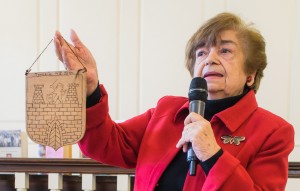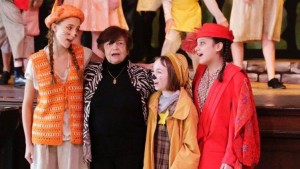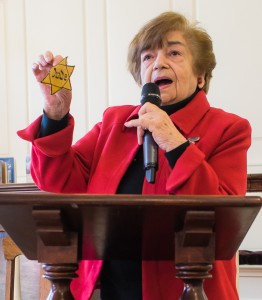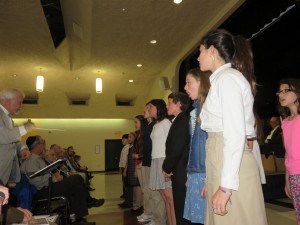Holocaust survivor to appear with ‘Brundibár’ performances
By DEAN M. SHAPIRO, Exclusive to the CCJN
During the weekend of May 12-15, when performances of the children’s opera, Brundibár, are being staged in the U.S. Freedom Pavilion of the National World War II Museum, 85-year-old Ela Stein Weissberger will be in the audience.

Ela Weissberger, the last survivor who performed in the children’s opera Brundibár , holds a crest of Terezin she made for her mother in 1944. (Photo by Tamar Grinshpon)
For Weissberger this will, once again, be a time for her to reconnect with a segment of her past that took place during one of the darkest periods in recorded history. Brundibár was performed in a Czechoslovakian concentration camp during the Holocaust and, as a young teenager, Ela Stein sang one of the key roles in all 55 performances of the production there.
Coming to New Orleans for the first time, nearly 73 years after first appearing in her role, Weissberger will attend all three performances here. She will also host a webinar for students, give a talk at a Shabbat program at Temple Sinai and participate in several other programs and activities related to the experiences she had while imprisoned for three years in the Theresienstadt (Terezin) Concentration Camp.
Sponsored by the New Orleans Opera Association and hosted by the National World War II Museum, Brundibár will be performed on Saturday, May 14 at 7:30 p.m. and on Sunday, May 15 at 3:00 and 7:00 p.m. The doors open half an hour before each performance.
Robert Lyall, general and artistic director of the New Orleans Opera Association, will act act a maestro, conducting a 14-piece orchestra at each performance. Eli Villanueva is the stage director.

Weissberger, second from left, at a recent performance of Brundibár in Poughkeepsie, NY. (Photo by Tamar Grinshpon)
The 40-minute children’s opera will be preceded by a short musical piece titled Friedl, which is a tribute to Friedl Dicker-Brandeis, a Jewish visual artist and designer who taught art to the children of Terezin – one of whom was Ela Stein. Villanueva composed the music from a libretto by Leslie Stevens.
Tulane University Vocal Arts chair, soprano Amy Pfrimmer, will sing the Friedl title role. Angielena Jambois will sing the role of Ela in the 16-member cast.
All performances will be sung in English.
The performances come just 10 days after Yom HaShoah, the annual Holocaust Memorial Day. This was intentional, according to Lyall, who planned and helped arrange for the stagings, along with Stephen Watson, the museum’s vice president.
Composed by Hans Krasa in 1938 from a libretto by Adolf Hoffmeister, Brundibár was first performed at a Jewish orphanage in Prague four years later. Soon after that Krasa and set designer Frantisek Zelenka were transported to Terezin, which held many of the leading Jewish artists, musicians and intellectuals from Czechoslovakia, Germany and Austria. By July 1943, nearly all of the children from the original chorus had also been transported there.
Reunited with the cast in Terezin, Krasa reconstructed the full score of the opera, based on memory and the partial piano score that remained in his hands, adapting it to suit the dozen or so musical instruments available in the camp. Zelenka designed a new set and directed the productions there which began on September 23, 1943. Krasa accompanied the orchestra on piano.

Ela Weissberger holds a Jewish star inmates were allowed to take off during performances at Thereseinstadt concentration camp. (Photo by Tamar Grinshpon)
Brundibár is the fanciful story of a young boy, Pepicek (Little Joe) and his young sister, Aninka (Annette) whose widowed mother is ill and needs milk to help her recover. The two children go out to sing in their village square, hoping to raise donations and, with the help of a Dog, a Cat, a Sparrow and a chorus of other children, they do.
However, a cantankerous organ grinder named Brundibár (Czech for “bumblebee”), who is also performing there, chases them off and steals their money. The Dog, Cat and Sparrow chase him down as he attempts to flee and they recover the money. Then the children, the animals and the chorus sing a victory song, lauding the triumph of good over evil.
To the inmates of the camp who witnessed the performances, the mustachioed organ grinder was a Hitler prototype. The opera and its moral gave them a glimmer of hope for his downfall and an end to their suffering.
Ela Stein was the Cat in every performance that was staged between September 1943 and September 1944. Although a few members of the children’s chorus are still alive, she is the last surviving member of the main cast.
In a telephone interview from her home in the New York City suburb of Tappan, NY, Weissberger recalled her joy at being selected for the role.
“I was 12 years old at that time,” she began. “When I got the letter stating that I was in the opera I was so happy to get the part. So I said to my mother, ‘You know, Ma, I will sing in an opera,’ and she said, ‘Really? In an opera?’ She had never heard that there were children’s operas. And I said, ‘I’ll be the Cat.’ She was thinking for a couple of minutes and then she said, ‘But (Richard) Wagner never had cats in his operas.’”
While interned in Terezin, all of the prisoners were required to wear yellow stars that read “Juden,” identifying them as Jews. “The only time we were allowed to take our stars off was during performances,” Weissberger recalled.
A special performance of Brundibár was staged in 1944 for representatives of the International Red Cross who came to inspect living conditions in the camp. Knowing the visit was coming, the Nazis orchestrated the scenario in Terezin to make it appear that the Jews housed there were living well and were happy. The inspectors were given maps with red lines indicating the path they would be traversing and they were not given an opportunity to inspect behind the facades. Nor were they allowed to interview inmates who might have had adverse things to say about their living conditions.

Robert Lyall, left, conducts a children’s choir in a performance of the closing scene from Brundibár. (Photo by Alan Smason)
The Brundibár production was perceived by the visitors as evidence the inmates of Terezin were happy and content, and a glowing report to that effect was submitted to Red Cross headquarters in Geneva, Switzerland.
A Brundibár production was also filmed for a Nazi propaganda movie titled Der Führer schenkt den Juden eine Stadt (“The Führer Gives the Jews a City”). Ela Stein was in portions of that film, performing her role.
Soon after completion of the filming, nearly all of the participants in the Terezin Brundibár production were herded into cattle trucks and sent to Auschwitz. Most were gassed immediately upon arrival, including Krasa, the performing children and the musicians.
In all, thousands of Jews, many of whom were children, died in the camp from dysentery, malnutrition, starvation and other ailments that would normally have been preventable. Countless thousands more were deported from Terezin to Auschwitz, Treblinka and other notorious death camps.
Ela, her mother and her aunt were miraculously spared and were still alive when the camp was liberated by the Russian army in May 1945. The three returned to Prague, where they refused to accept communist rule electing to emigrate to the newly independent State of Israel.
While in Israel, Ela enlisted in their navy’s Secret Service and later married an Israeli soldier named Leopold “Leo” Weissberger. In 1954 they had a daughter they named Tamar and five years later the family emigrated to the U.S. where Ela pursued a career as a graphic artist and interior designer. By the 1980s, with renewed interest in Holocaust survivor stories, she began traveling throughout the country and abroad, attending Brundibar productions and speaking about her experiences.
In 2006 she co-authored – with Susan Goldman Rubin – a 40-page, illustrated, autobiographical children’s book titled, The Cat with the Yellow Star: Coming of Age in Terezin. She has also been written about in other books, most notably The Girls of Room 28: Friendship, Hope, and Survival in Theresienstadt by Hannelore Brenner, published in 2009.
In a recent interview with the American Grandparents Association, Weissberger stated, “I want to speak for the children who died. I ask people to remember my friends. By doing this, they stay alive in our hearts and minds. I’m the bridge between today’s children and generations to come. And if we, as survivors, keep talking, we’ll be heard. We can’t keep it silent. It’s a part of our bodies.”
Singing key roles in the New Orleans production are Spencer Reichman (Brundibár), Brandon Marquez (Pepicek), Annie Cohen (Aninka), Annemarie Bernard (Dog), Madeleine Cucullu (Cat), Isabella Farrugia (Sparrow) and Anna Duong (Mother). In supporting roles are Sophia Parigi (Doctor), Eli Zitler (Ice Cream Man), Kadin Gaubert (Baker), Evan Johnson (Milkman) and David Murray (Policeman).
The 40-member children’s chorus, with members from schools all over the New Orleans area, is directed by New Orleans Opera chorusmaster Carol Rausch, who also accompanies all of the performances of Friedl and Brundibár on piano.
Weissberger will arrive in New Orleans, accompanied by her daughter, Tamar “Tammy” Weissberger Grinshpon from Raleigh, N.C. on Thursday, May 12. That evening she will attend a screening of Not the Last Butterfly, a documentary film produced by the San Diego-based Holocaust awareness organization, The Butterfly Project. The screening will take place at Temple Sinai, 6227 St. Charles Avenue, New Orleans, at 7:00 p.m.
The following day, Friday May 13 at noon, she will conduct a webinar from the National World War II Museum aimed primarily at students. That evening, at 6:00 p.m., she will be the guest speaker at Temple Sinai’s Shabbat services. Cantor Joel Colman, and Rabbi Edward Paul Cohn helped arrange Weissberger’s schedule, along with her travel, accommodations and other details.
On Saturday, May 14, Weissberger will visit The Butterfly Project Family Workshop at the museum from 2:00-3:30 p.m. Participants in the workshop will paint ceramic butterflies, each one representing a child victim of the Holocaust. An estimated 1.5 million children are believed to have died in concentration camps and The Butterfly Project aims to have that many ceramic butterflies painted and available for display on completion.
Both the webinar and workshops are free but advance registration is required. Call the museum at 528-1944 for details.
At a V.I.P./patron reception at the museum on Saturday at 6:30 p.m. Weissberger will deliver a brief introduction and sign programs. She is also expected to have copies of her books available for sale as well. At 7:30 she will attend the opening performance of Brundibár and meet and greet the performers afterward.
On Sunday, May 15, Weissberger will attend both the 3:00 and 7:00 performances and sandwich in between another appearance at a V.I.P. and patron reception at 4:00 p.m.
Tamar “Tammy” Grinshpon, who has accompanied her mother throughout the U.S., Europe, Africa and South America for most of the past three years, is in awe of everything that the Holocaust survivor who gave birth to her has accomplished in her lifetime.
“She was the Cat in the opera and they say that cats have nine lives,” Grinshpon said. “My Mom has gone through so many different lives; from the child opera singer to the soldier, to the commercial artist, and now to the renowned public speaker traveling the world and telling her story. She’s had such an amazing life.”
For more information about Brundibár and to secure tickets, contact the New Orleans Opera Association at 504-529-2278, click here to visit the website or contact the National World War II Museum at 504-528-1944. Ticket prices are $20.00 for adults, $5.00 for children 5-18 years old and $18.00 for museum members.



